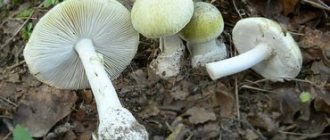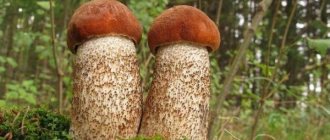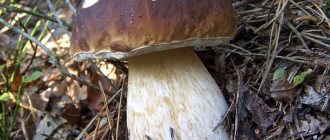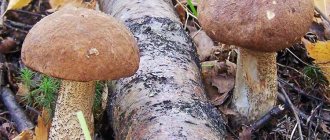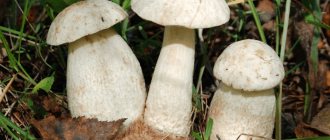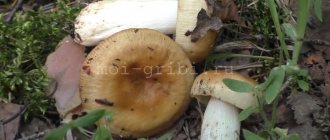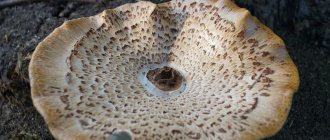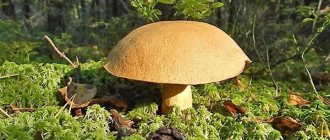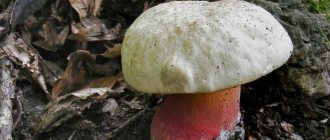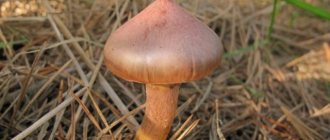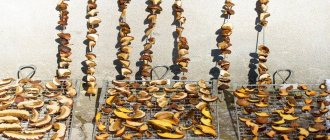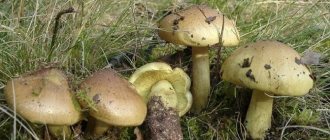False boletus: how to distinguish, signs of false boletuses, photos of doubles
False boletus is a mushroom that is very similar to the real boletus in its external structure, but is not suitable for consumption. This is usually the name given to not just one mushroom, but several varieties, so as not to bring inedible fruiting bodies from the forest, it is necessary to carefully study the false doubles.
Are there false boletuses?
Boletus, aspen, obabok or redhead is considered a unique mushroom, which is almost impossible to confuse with other varieties. His appearance is very recognizable. The redhead has no poisonous counterparts and belongs to the category of the safest.
But at the same time, it is still possible to confuse obabok with inedible fruiting bodies; they do not pose a danger, but they have a very unpleasant taste. There is no specific mushroom with the name “false boletus” in nature. This word is used to describe other mushrooms that have their own names, but are very similar to redhead in external structure.
Varieties of false boletuses
Most often, true aspen mushrooms are confused with several species - the edible boletus mushroom and the inedible gall and pepper mushrooms. In order not to make a mistake when collecting, you need to study false and real boletuses in more detail.
boletus
Contrary to its name, boletus is found not only near birches, but also under other deciduous and even coniferous trees. The same applies to boletus, so it’s really easy to confuse them, especially since they belong to the same genus Obabkov.
The similarity between aspen and birch lies in their structure. The boletus has a strong long leg about 15 cm in length, with a slight narrowing in the upper part, the color of the leg is white and covered with dark scales.
The cap of the fruiting body is dense and fleshy, at a young age it is hemispherical, convex, and in an adult it is pillow-like, with a tubular lower surface.
According to the color of the cap, the boletus twin is usually light brown or dark brown, brown-yellow, olive-brown.
The main difference between boletus and aspen is that the edible false boletus does not have a reddish tint in the color of its cap.
But the real aspen boletus has such a shade; it is not without reason that it is called redhead, it has a much brighter color. Also, the leg of aspen wood is smoother, cylindrical in shape and without narrowing at the top.
When cut, the flesh of the false edible counterpart turns slightly pink, and in the real aspen it acquires a bluish color.
Important! It is not dangerous to confuse aspen with its edible relative, but an experienced mushroom picker should be able to distinguish between varieties of aspen.
Another false redhead is the famous bitterling, or gall mushroom, which is very similar in color and structure to several species from the Boletaceae family.
It grows in the same places as obabok - in deciduous and coniferous forests, in symbiosis with pines, birches, aspens and other trees, close to the trunks.
The double can be found from June to early November, alone and in groups, all this makes it look like the redhead.
Real and false redheads are very similar in appearance. Gorchak also has a wide and dense fleshy cap with a tubular bottom layer; at a young age it is convex, and over time it becomes prostrate and cushion-shaped. The color of the skin on the cap can be yellowish-brown, dark brown, chestnut; the stem of the bitterling is light - from yellowish to light ocher.
You can distinguish bittersweet from real aspen first of all by its stem. In true aspen it is covered with dark small scales that can be easily peeled off with a knife.
In the photo of the false boletus mushroom, you can see that the bitterling leg is dotted with a “vascular” mesh, consisting not of scales, but of deep and wide stripes.
Usually the double does not have a reddish tint in the color of the cap, and if you cut it in half, it will not turn blue, but turn pink.
Bitterweed is not poisonous and is not hazardous to health. But it cannot be used as food, since its pulp is unbearably bitter. Neither soaking nor boiling eliminates this feature. If it accidentally gets into a soup or roast, bitter green simply spoils the dish and makes it inedible.
Advice! Bitter taste is another sign that you can look for when picking. If there is any doubt whether the redhead found is real or false, just lick the flesh on the cut and the answer will become obvious.
This mushroom, similar to boletus, also belongs to the Boletaceae family, but is inedible. It is similar to obabok in its structure and color. The pepper mushroom is characterized by a low cylindrical stalk, straight or slightly curved.
The cap, cushion-shaped in adults and convex in young fruiting bodies, is copper-red, dark orange or reddish-brown.
Its surface is smooth, dry and slightly velvety, and the underside is covered with small rusty-brown tubes.
Like the redhead, the double often grows under birch, aspen and pine trees in mixed and coniferous forests, prefers dry places, and bears fruit most actively from July to October. This increases the risk of confusing it with a true aspen boletus.
Meanwhile, the false double has quite a lot of differences from the redhead. First of all, the pepper mushroom is usually smaller in size - its leg rises only 8 cm above the ground, and the diameter of the cap, even in adulthood, rarely exceeds 6 cm.
Also, there are no scales on the leg of the false boletus, its color is uniform, almost the same as that of the cap, but maybe a little lighter.
False redhead is easy to recognize if you cut its cap. The flesh of the pepper mushroom will be yellow-brown and turn red when cut, and will emit a faint peppery smell. If you taste the pulp, it will turn out to be very sharp and burning.
Pepper mushroom does not pose a health hazard when consumed once. Opinions about the edibility of false boletus are divided - some mushroom pickers consider it inedible, others classify it as conditionally edible fruiting bodies. The problem is that the pepper mushroom tastes too pungent and can ruin any dish.
Attention! If you boil the pulp for a very long time, the pungent taste becomes weaker, but the effort to process the false aspen boletus is simply not worth the result. In addition, Western scientists are of the opinion that with frequent consumption of pepper mushroom, the substances it contains negatively affect the functioning of the liver.
If you carefully study the characteristics of the boletus and photographs of its doubles, then you can deduce several basic characteristics of false boletuses.
The true redhead has a tall, dense and light-colored leg, covered with recognizable gray scales. A real aspen tree should not have a yellowish or reddish network or “vessels”; these are signs of false doubles.
If you break the redhead in half, its flesh will remain white or slowly turn blue or black. If the mushroom looks like a boletus and turns pink or red when cut, then it is a double.
The raw pulp of true aspen has a neutral taste and does not bring any unpleasant sensations. Inedible doubles taste bitter or hot, and there is no desire to eat them.
In size, a real boletus is quite large - about 15 cm in height and the same in diameter of the cap. Some of the look-alikes, such as the pepper mushroom, are much smaller.
Tips and tricks from experienced mushroom pickers
Experienced mushroom pickers, aware of the smallest nuances and differences between true and false boletuses, give beginners some more advice:
- When collecting, you should not focus solely on the shade of the cap. Depending on the age, growing conditions and even lighting in the forest, false boletuses may have a reddish skin color, but the characteristic shade of the true boletus may be barely noticeable. It’s better to look at the differences in structure and the flesh on the cut.
- Although false redcaps have an unpleasant odor, it is not always noticeable. To make sure that the fruiting body is inedible, it is better to lightly lick its flesh. Since the doubles are not poisonous, this will not cause harm, and will clarify the situation.
Mushroom pickers also note that false boletuses with a bitter or pungent taste usually look much more attractive than true redheads.
They are distinguished by smooth caps and legs, untouched by insects, and make you want to cut them off and put them in a basket.
However, midges and worms do not eat false caps precisely because their flesh is too bitter, but the edible red cap is of interest to both humans and insects.
Conclusion
False boletus is an edible or inedible mushroom that can easily be confused with the real boletus. There are few such varieties, all of them are well studied. It is important to emphasize that the redhead has no truly toxic counterparts.
Source: https://fermilon.ru/sad-i-ogorod/griby/lozhnyy-podosinovik-kak-opredelit-foto-i-opisanie.html
Tips and tricks from experienced mushroom pickers
Experienced mushroom pickers, aware of the smallest nuances and differences between true and false boletuses, give beginners some more advice:
- When collecting, you should not focus solely on the shade of the cap. Depending on the age, growing conditions and even lighting in the forest, false boletuses may have a reddish skin color, but the characteristic shade of the true boletus may be barely noticeable. It’s better to look at the differences in structure and the flesh on the cut.
- Although false redcaps have an unpleasant odor, it is not always noticeable. To make sure that the fruiting body is inedible, it is better to lightly lick its flesh. Since the doubles are not poisonous, this will not cause harm, and will clarify the situation.
Mushroom pickers also note that false boletuses with a bitter or pungent taste usually look much more attractive than true redheads. They are distinguished by smooth caps and legs, untouched by insects, and make you want to cut them off and put them in a basket. However, midges and worms do not eat false caps precisely because their flesh is too bitter, but the edible red cap is of interest to both humans and insects.
How to distinguish false boletus, signs of false boletus, photos of doubles
| Name: | Boletus |
| View: | Edible |
The deceptive boletus is a mushroom that is very similar to the real redhead in its external structure, but is not suitable for consumption. Since, as a rule, not one mushroom is named, but several options, so as not to bring inedible fruiting bodies from the forest, you should carefully study the false doubles.
Bile mushroom
Another deceptive redhead is the well-known mustard, or gall mushroom, which is strongly reminiscent in color and structure to several species from the Boletaceae family.
It grows in the same places as obabok - in deciduous and coniferous forests, in symbiosis with pines, birches, aspens and other trees, next to the trunks.
The double can be met from June to early November, alone and in groups, all this makes it look like a redhead.
Real and deceptive redheads are similar in appearance.
Gorchak also has a wide and dense fleshy cap with a tubular lower layer; at a young age it is convex, and over a period of time it becomes prostrate and cushion-shaped.
The color of the skin on the cap can be yellowish-brown, dark brown, chestnut; the stem of the bitterling is light - from yellowish to light ocher.
The first thing you can do to distinguish bittersweet from real aspen is by looking at its stem. In true aspen it is covered with dark, very small scales that are easily cleaned with a knife.
In the photo of the deceptive boletus mushroom, you can see that the bitterling leg is dotted with a “vascular” mesh, consisting not of scales, but of deep and wide stripes.
In most cases, the double does not have a reddish tint in the color of the cap, and if you cut it in half, it will not turn blue, but turn pink.
Bitterweed is not poisonous and not hazardous to health. However, it cannot be used for food, since its pulp is unbearably bitter. Neither soaking nor boiling eliminates this characteristic. If it accidentally gets into a soup or roast, the mustard simply spoils the dish and makes it inedible.
Pepper mushroom
This mushroom, similar to boletus, also belongs to the Boletaceae family, but is considered inedible. It is similar to the obabok in its structure and color. The pepper mushroom is characterized by a low cylindrical stem, smooth or slightly curved.
The cap, cushion-shaped in adults and convex in young fruiting bodies, is copper-red, dark orange or reddish-brown. Its surface is smooth, dry and slightly velvety, and the bottom is covered with very small rusty-brown tubes.
Like the redhead, the double often grows under birch, aspen and pine trees in mixed and coniferous forests, prefers dry places, and bears fruit most vigorously from July to October. This increases the risk of confusing it with a real boletus.
Meanwhile, the false double has quite a lot of differences from the redhead. First of all, the pepper mushroom is in most cases smaller in size - its stem rises only 8 cm above the ground, and the diameter of the cap, even in adulthood, rarely exceeds 6 cm.
Also, there are no scales on the leg of the false boletus, its color is the same, almost the same as that of the cap, but maybe a little brighter.
The deceptive redhead is easy to recognize if you cut its cap. The flesh of the pepper mushroom will be yellow-brown and turn red when cut, and a faint peppery aroma will emanate from it. If you taste the pulp, it will be very sharp and burning.
Pepper mushroom does not pose a health hazard when consumed once. Opinions about the edibility of false boletus are divided - some mushroom pickers consider it inedible, others classify it as conditionally edible fruiting bodies. The difficulty is that the pepper mushroom has an overly pungent taste and can damage any dish.
How to distinguish boletus from false mushrooms
If you need to study the characteristics of the boletus and photographs of its doubles, then you can derive several basic characteristics of false boletuses.
The true redhead has a tall, dense and light-colored leg, covered with recognizable gray scales. A real aspen tree should not have a yellowish or reddish network or “vessels”; these are signs of false doubles.
If you break the redhead in two, its flesh remains white or gradually turns blue or a shade of black. If the mushroom looks like a boletus and turns pink or red when cut, then it is a double.
The raw pulp of true aspen has a neutral taste and does not bring any unpleasant feelings. Inedible doubles taste bitter or hot, and there is no desire to eat them.
The size of a real boletus is quite large - about 15 cm in height and the same amount in the diameter of the cap. Some of its lookalikes, such as the pepper mushroom, are much smaller in size.
Recommendations and advice from experienced mushroom pickers
Qualified mushroom pickers, aware of the very small nuances and differences between true and false boletuses, give beginners a couple more recommendations:
- When collecting, you don’t need to focus only on the shade of the cap. Depending on age, growing conditions and even lighting in the wilderness, false boletuses have a reddish skin color, but in true boletuses the distinctive shade may be invisible. It’s better to look at the differences in structure and the flesh on the cut.
- Although false redheads have an unpleasant odor, it is not always clearly felt. To be sure that the fruiting body is inedible, it is better to lightly lick its flesh. Since the doubles are not poisonous, this will not cause any damage, but will clarify the situation.
Mushroom pickers also note that false boletuses with a bitter or pungent taste in most cases look more attractive than true boletuses.
They stand out with their perfect caps and legs, untouched by insects, and make you want to remove them and put them in a basket.
However, midges and worms do not eat false mushrooms due to the fact that their flesh is excessively bitter, but the edible redhead is of interest to both humans and insects.
Why does the boletus darken when cut?
All boletuses have white flesh, but if the fruiting body is damaged, it turns blue, purple, or black. Only isolated spots may appear on the pulp, or the entire inner surface may darken.
Boletus cut
This phenomenon is not dangerous, although it spoils the appetizing appearance of the little guy. The fact is that it contains a special substance - variegated acid. When the integrity of the pulp is compromised, the process of interaction of this acid with air begins. Oxidation occurs to form quinomethide anion with a blue hue.
The darkening of the mushroom pulp is similar to the oxidation of some vegetables and fruits, which also change color. In its pure form, the pigment oxidizes more slowly, therefore, red mushrooms contain substances that accelerate this process.
How to distinguish boletus and false boletus: photo and description
Experienced mushroom pickers who have been collecting for a long time can easily distinguish an edible mushroom from a poisonous one. This is very important, as even the slightest mistake can cost your life. There are many false mushrooms that are quite similar in appearance to the edible ones we are familiar with. This article details how to identify false aspen and how it threatens human health.
Description of the false boletus
The mushroom, which is considered a twin of the boletus, is called bitter, and also gall mushroom . It can be found mainly in coniferous places. The bitterling cap is small, round and fleshy. Its color is red-brown, light red or yellow - red.
The inside of the cap is white, but the older the bitterling becomes, the darker it is. The leg is swollen, curved and thickened near the base. Covered with small brown or black scales. It has a tubular structure inside, and when cut, the light color begins to turn red or pink.
Important! In bitterling, like aspen, the stem does not have a membranous ring.
The flesh of the false aspen is slightly pink. It tastes quite bitter - even high temperature treatment does not help get rid of the bitterness. Bittersweet itself is not poisonous, but its bitterness makes it inedible.
Even if you can overcome the unpleasant taste with seasonings, it is still better not to eat it - all the bitterness turns into harmful substances that remain in the liver, disrupting its functioning. Real aspen boletuses, on the contrary, are healthy and remove all harmful substances from the organs, and the broth prepared from them strengthens the immune system.
Differences between a false boletus and a real one
The mushrooms are very similar, therefore, in order to distinguish a real boletus from a double, you need to know some nuances.
Important! Gorchak always looks beautiful, because due to its taste, all living creatures will avoid it. This factor is worth remembering during mushroom picking.
To distinguish between these two types, you need to look at these features:
- look carefully at the pulp: in bitterling it is pink, and in edible aspen it is white or with a blue tint;
- the leg of the double has a pink or yellow mesh, but the real aspen does not have it;
- inedible mustard grows only in coniferous areas.
Types of false boletuses
Even experienced collectors have come across mushrooms that are similar to boletuses.
In fact, there are two types of false aspen trees:
They both look like true boletus, but the bitter taste prevents them from being considered edible.
Bile mushroom
It is easy to confuse it with several varieties of noble mushrooms, for example, boletus, boletus and boletus. The cap is usually dark red and the leg is white. Grows mainly in coniferous forests. You can find it on tree roots and rotten stumps.
It is considered inedible due to its very unpleasant taste. Even a small part of a mushroom can ruin the entire dish. For this reason, during the autumn harvest, it is necessary to remember that even if one such specimen ends up in the basket, it will ruin the entire harvest.
Edibility
As mentioned above, boletus lookalikes are not dangerous to humans, but are practically inedible.
You can try to overcome the bitterness with vinegar and marinades, but it’s hardly worth it. Although these mushrooms are not harmful in small quantities, they also do not contain any beneficial substances.
For these reasons, in order to prepare a truly tasty dish, it is better to use real aspen boletuses.
Signs of poisoning and first aid
Often, novice mushroom pickers do not know how to distinguish poisonous mushrooms from edible ones, which often leads to serious problems and sometimes death.
- Signs of poisoning by such products are expressed in the following symptoms:
- headache;
- abdominal pain;
- nausea, vomiting;
- thirst;
- convulsions;
- hallucinations;
- cold extremities;
- loss of consciousness;
- breathing disorder.
If you have identified these signs in yourself or your loved ones, and the day before you consumed mushrooms, immediately call an ambulance. It is important not to throw away leftover food so that doctors can quickly determine the type of poison.
- What to do before the doctors arrive:
- drink at least 6 glasses of water with soda;
- try to induce vomiting - it will make the poisoning easier. If vomiting is already present, then this does not need to be done;
- take laxatives and sorbents, for example, activated carbon - 10 tablets.
There are a large number of poisonous mushrooms in nature, and even most experienced collectors can sometimes confuse the aspen mushroom with its double. Therefore, before going on a “silent hunt”, it is important to study the description of each species in detail, since inexperience can lead to irreversible consequences.
Source: https://fermer.blog/bok/griby/sedobnye-griby/podosinovik/13070-kak-otlichit-lozhnyj-podosinovik.html
Edibility
As mentioned above, boletus lookalikes are not dangerous to humans, but are practically inedible. You can try to overcome the bitterness with vinegar and marinades, but it’s hardly worth it. Although these mushrooms are not harmful in small quantities, they also do not contain any beneficial substances. For these reasons, in order to prepare a truly tasty dish, it is better to use real aspen boletuses.
Did you know? In some Muslim countries, eating mushrooms is considered a sin.
Edible and false boletus - what are the differences?
Boletus, or redhead, aspen is an edible mushroom, which experts classify as the second category. However, many lovers of “quiet hunting” value it no less than porcini mushroom. It is in no way inferior in taste and aroma.
Boletus - a valuable edible mushroom
In fact, boletus is a common collective name for several species of mushrooms of the genus Leccinum or Obabok (lat. Leccinum) of the Boletaceae family.
There are many guises of the redhead:
- pine,
- spruce,
- white,
- red,
- oak,
- black scaly,
- multi-skinned,
- and colored-legged.
All of them are edible. And due to their remarkable appearance, it is almost impossible to confuse them with any poisonous counterpart. Photos of mushrooms eloquently testify to this.
Time to collect boletuses: late summer - mid-autumn. They are found in coniferous, deciduous and mixed forests, often growing with a certain type of tree, forming a kind of mycorrhiza. Thus, the pine boletus prefers proximity to pine trees. Spruce, oak - their names speak for themselves.
Externally, redheads of different species can differ significantly. Oak and spruce trees have a chestnut cap, while pine trees have a richer red-brown color. The white boletus has white all parts of the fruiting body, while the heteroskinned boletus has a yellow-brown or red-brown cap.
The colored-legged boletuses are very different from their fellows. Their cap has a pinkish tint, the leg is covered with red scales, and its base is ocher-yellow. The black-scaled boletus has a rich red cap.
An additional feature of the boletus subset: all redheads, despite such a variety of forms, have a characteristic feature - their flesh quickly darkens when cut, acquiring a blue, purple and even black color.
What does a false boletus look like?
False boletus does not exist as an independent species of mushroom. However, some may still confuse obabok with mustard, or as it is called in the scientific world - gall fungus (lat.
Tylopilus felleus) with a very bitter taste.
But it’s enough to look at the photo once, read the description and tips on how to distinguish a real boletus from a false one in order to calmly collect the stuff and not worry about your health.
False boletus, popularly known as bitter or gall mushroom, is very beautiful, which is not surprising. After all, neither insects nor animals eat it.
False boletuses are so bitter that this is simply impossible.
However, they are not classified as deadly poisonous mushrooms, although the toxic substances they contain, in high concentrations, can harm the liver, disrupting its function.
Bile mushrooms, like boletus mushrooms, belong to the Boletaceae family. Their habitat is quite diverse. They can be found in coniferous and mixed forests from July to October. One single bitter bitter can ruin the entire dish. And neither prolonged soaking nor heat treatment can remove bitterness. On the contrary, it is only intensifying.
Despite this, some mushroom pickers claim exactly the opposite. They say that if bitterness is soaked in salt water for several days, changing the solution two to three times a day, the bitterness will disappear and the mushrooms will become suitable for pickling. And yet, scientists warn that this method is unlikely to remove all toxins and make gall mushrooms suitable for consumption.
How to distinguish a real boletus from a false boletus? - Very simple!
- The pulp of bitterling is white or cream in color; when cut, it acquires a pinkish tint. And although the boletus pulp is white, at the slightest damage or cut it quickly turns blue and even black. However, this does not affect its taste in any way.
- The appearance of the gall fungus is also different from the real gall fungus. The false boletus has a brown mesh on its leg, while its edible relative has black scales or dots.
- The cap of the bitterling is smooth, its color varies from olive to yellow-brown. The underside is convex. When young, the fruiting bodies have a spongy layer of cream color, but later it turns dirty pink.
Some of the mushroom pickers who have been engaged in “silent hunting” for several years can also sometimes make mistakes. But they believe that bitterling is more similar to pine white mushroom or summer white mushroom, and not to boletus. And if they doubt who is in front of them, they can simply lick or try a small piece, which they then spit out.
Strong bitterness always confirms their guess.
Symptoms of poisoning and first aid
False boletus is an inedible mushroom, but it is not poisonous. Its bitterness is dangerous, as it contains toxic substances that have a negative effect on the liver. But eating so many bitterlings at one time to cause poisoning is almost impossible.
That is why intoxication with them is quite rare. This happens mainly due to the use of canned bitters, since vinegar and spices partially mask the unpleasant taste.
However, even in this case, the main symptoms of poisoning by false boletus do not appear immediately, but only after a few weeks. Of course, weakness and dizziness may occur immediately after eating the dish, but they quickly pass.
And when enough toxins accumulate in the liver, they will begin to destroy it. Only then will signs of damage to this organ appear in the form of impaired bile secretion. Sometimes, if diagnosis and treatment are not timely, liver cirrhosis may develop.
Since acute poisoning does not occur immediately after consuming bitter herbs, first aid is usually not provided. It happens that a person has long forgotten when he tried them, and suddenly symptoms of liver damage appear. Of course, he cannot understand the cause of the disease. And the once eaten false boletuses may be to blame for everything...
Source: https://gribnik.info/lognuy-podosinovik/
Why “boletus”?
The scientific name of this mushroom is Leccinum aurantiacum. But in everyday life it is known as the aspen boletus, since attentive lovers of “quiet hunting” have noticed: more often than not, this beauty is found under aspen trees. Although you should not be surprised if you are lucky enough to find it under spruce, pine, birch, oak, in coniferous-deciduous forests and even on the edges or clearings in groups or alone. True, there are representatives of some varieties that differ from their “brothers” from under the aspens.
This type of mushroom is common in Eurasia and North America, in temperate forests. Found in shady thickets, on moist soil. These beauties love to hide among blueberries, ferns, mosses and grass, although sometimes their bright caps are visible along forest paths.
The classic boletus is a mushroom that resembles a boletus, but with an orange-red cap (up to 20 cm in diameter), a stocky stem and dense flesh. It reaches its largest dimensions on the 10th day of growth, some specimens grow up to 2 kg. A distinctive feature of a young mushroom is a hemispherical cap, the edges of which are pressed tightly against the stem. The skin on the cap is not sticky, like butterfish, but dry, in some it is velvety. The club-shaped leg in adult boletuses reaches 22 cm. It is easily recognized by its small black or brown scales. The “hunt” for boletus lasts from the beginning of summer until October.
Because of its bright cap, in the old days it was called by many other names: red mushroom, redhead, krasnik, obabok, chelish. Some suggest that the mushroom got its name also because the color of the cap resembles the bright autumn leaves of aspen.
False boletus: description, photo
Not only edible mushrooms are found in the forest. They often have poisonous or unedible counterparts. One of these species is false boletus (gorchak).
Description of the false boletus
Description
Boletus, also known as red boletus or simply aspen, is a healthy and tasty edible mushroom. He is recognized by his bright yellow or orange cap, reminiscent of an autumn leaf in its color. However, even such a unique mushroom has a double. It is important not to confuse them.
False boletus has characteristic distinctive features:
- It grows mainly in coniferous forests, where there are spruce and pine trees. Less commonly, it can form symbiosis (mycorrhiza) with the roots of birch and oak. The edible mushroom never appears near coniferous trees.
- If a real boletus has a pattern on its leg in the form of notches (scales), then its double has a dense gray-brown mesh.
- False boletuses have a tubular hymenophore layer, just like their edible fruiting bodies. But for them it is white (for a young mushroom), pink or dark pink (for an old one). The edible boletus species has a yellowish tubular substance.
- False boletus is rarely wormy.
- On cuts (breaks), the flesh turns pink. A real redhead turns blue and then turns black.
- The stem of the bitterling plant is darker (brownish, greenish) than that of the edible fruiting bodies.
- The shape of the cap of the false aspen is cushion-shaped, more convex in the center.
- To finally make sure that the boletus is false, lightly lick the cut. Strong bitterness or lack thereof will indicate the true nature of the fruiting body.
Irina Selyutina (Biologist):
The pulp of the gall fungus, or bitterling, contains toxins that give it a bitter taste. However, it’s still not worth trying the bitter taste. The compounds that give such a specific taste are easily absorbed even through the surface layer of the tongue and spread through the blood. And this can cause liver problems in the future.
Most often, bittersweet is eaten only by accident, when it ends up in canned food in a mass of mushrooms, where vinegar and other spices hide its bitter taste. Symptoms may not appear immediately, but even after a few weeks or a month, when the liver cells are already attacked.
On the first day after consuming gall mushrooms, quickly passing weakness and dizziness appear, which a person may not associate with eating mushrooms. But in a few weeks the liver will go on strike, and its bile secretion function will be impaired.
If the victim eats a large amount of gall fungus, liver cirrhosis may develop. Therefore, you should be careful about collecting scraps and discard doubtful specimens.
False boletuses grow throughout the summer and in the fall, until October. They are often found in clearings, rotted stumps, and tree roots. They can grow in groups or singly. They are similar to boletus (in shape), boletus and boletus (in the color of the cap).
Use in cooking
False boletuses are inedible. They have taste qualities that make them unsuitable for food. The taste of the doubles resembles wormwood, their pulp is so bitter.
To avoid misunderstandings when preparing culinary dishes, always carefully inspect the fruiting bodies. If even one false boletus gets into the pan, all its contents will be spoiled.
The flesh of the mushroom is fleshy and pleasant to look at, but the bitterness cannot be destroyed by any cooking, although some mushroom pickers make soup from mustard and claim that drying neutralizes all the defects of the fruiting bodies.
Dried lookalike soup
Bitter mushrooms are very bitter
To begin with, the bitters are dried. To do this, they are cut into small pieces.
Dried pieces of bitterlings are practically no different in appearance and smell from their noble counterparts. To test the taste, bite the dry pulp. There should be just a slight hint of a little “spice.”
After this, the bitterlings are soaked in water. After a while, it is drained, and the swollen mushroom mass is thoroughly washed several times: this allows the remaining bitterness to be removed. Fresh water is used to cook the soup. The mustard mushrooms are immersed in it, the pan is put on the fire, and the mushroom broth is waited for readiness.
Chop potatoes, carrots, a little onion, immerse them in a saucepan one by one, add salt. Cook until done. The broth turns out transparent. Add a spoonful of sour cream to each serving. There is often a weak, almost imperceptible, but not bitter aftertaste, similar to a slight “pepper.”
The bitterness of the false mushroom, when entering the body, introduces some (in some cases quite strong) dissonance into the functioning of the liver, so it is better to refrain from culinary experiments.
Application in medicine
Medicine has long begun to use false boletus to restore the liver after damage. Preparations with a choleretic effect are made from them.
Bittersweet, like many other fruiting bodies of various types of edible mushrooms, contains elements with an antiviral effect, so this mushroom soup is useful to eat during colds.
“Suicide mushroom” darkens on the cut HOW TO IDENTIFY A FALSE MUSHROOM FROM THE REAL one! book: Thomas Lesso. MUSHROOM ASLEON Collecting mushrooms on the shock mycelium. Mushrooms in the taiga.
How long does the boletus grow? When to collect?
Boletuses occupy a leading place in terms of growth rate. For example, a mushroom can grow a couple of centimeters in a day. Weather conditions affect the growth rate of boletuses.
Stages of boletus growth - from the youngest to the most mature mushroom
After a heavy rain within a day, they become quite impressive in size, since they quickly absorb moisture from the soil and all useful substances. By the way, the absorption of harmful substances by mushrooms also occurs, so it is very important to collect them only in environmentally friendly areas.
Interesting fact : the lifespan of mycelium (mycelium) reaches 80 years. In order for boletuses to grow in the same place repeatedly, they should be collected carefully.
If it rains frequently, then the collection of redheads can continue throughout the summer and autumn until it gets colder. After the rain, just wait a day - the mushrooms will already have reached the desired size. If cold weather persists, the red mushroom takes 3-4 days to reach its optimal size.
How to identify false boletus, description of the mushroom + Photos and
False boletuses. Our forests are rich in different types of mushrooms, and lately “silent hunting” has become increasingly popular. An experienced mushroom picker can easily determine whether a mushroom is edible or poisonous, but for a beginner it is much more difficult to cope with this task.
Boletus (redhead, aspen) is a common collective name for several species of mushrooms of the genus Leccinum or Obabok. Belong to edible mushrooms of the second category. Among mushroom pickers, it is valued much less than the king of mushrooms, the white one. The collection time is at the end of summer - mid-autumn. In appearance, boletuses of different types can differ significantly from each other.
Therefore, it is especially difficult for novice mushroom pickers when they encounter false boletuses, because in appearance they are very similar to edible ones. In this article, we will find out the characteristic signs of false boletus, how to distinguish edible from inedible, and find out what danger it poses to the human body.
Description of the false boletus
False boletus (bitter or gall mushroom) is capable of forming symbiosis exclusively with coniferous trees, therefore it is found in forests where spruce, pine and fir grow from July to October.
The mushroom is very beautiful in appearance, but has a bitter taste, so neither animals nor insects eat it. Bittersweet is not a deadly poisonous mushroom, but contains toxic substances that disrupt liver function.
hat
The cap has a smooth, rounded-convex surface. Its colors are very diverse: red-brown, yellow-red, red-orange, olive. Young mushrooms have a milky interior, but with age it becomes gray.
Leg
The leg of the false boletus is slightly swollen, irregular in shape, thickened at the base, on which there is a yellowish or pinkish mesh. The surface of the leg is covered with small scales. The inner layer has a tubular structure; when cut, the white color changes to pink-red.
Pulp
Gorchak has pink flesh with a pronounced bitter taste. Even after heat treatment, the pulp does not cease to taste bitter. Although many mushroom pickers claim that if bitterness is soaked in salt water for several days, and the solution must be changed up to three times a day, the bitterness will disappear and the mushrooms can be pickled.
What danger does false boletus pose?
Both experienced and novice mushroom pickers can confuse bitterling with boletus during a “quiet hunt.” And even if a person ate false boletus, he will not experience acute poisoning, since for this it is necessary to eat them in large quantities.
https://www.youtube.com/watch?v=H3315O34qFA
The question arises, how can you even eat bitter if, as already mentioned, it tastes very bitter? It turns out that if you use it pickled, vinegar and spices will hide the unpleasant bitterness.
In this case, symptoms may appear after a couple of weeks.
And if a large amount of toxic substances that bitterling contains enter the body, they gradually disrupt the functioning of the liver, in some cases cirrhosis develops.
The main differences between edible and false boletus
When collecting boletuses, you should carefully study their appearance; there are certain nuances that will help you avoid running into an “impostor”:
- – the color of the pulp, in the edible boletus it is white or bluish-black, in the bitterling the pulp is pink-red;
- – false boletus has a yellow or pink mesh, which the edible mushroom of the same name does not have.
Important: the appearance of a poisonous mushroom is always presentable, since not a single representative of the animal world will eat it.
What is the danger
This mushroom is considered conditionally inedible. No, it is not poisonous, but you are unlikely to be able to eat it, and in large quantities. As mentioned above, its flesh is very bitter (it’s not for nothing that the mushroom is called bitter).
Even if you manage to overcome this taste with some special marinade or strong seasoning, it is still not recommended to eat it. After all, the bitterness of the gall fungus is converted into toxins, which then settle in the liver and disrupt its proper functioning. This does not bode well for health.
If you regularly eat true aspen boletus, it helps remove toxins and waste from the body. And the broth from these mushrooms helps restore the immune system after illness and has a good effect on the composition of the blood in case of low hemoglobin.
Composition and beneficial properties of boletus
These mushrooms are 90 percent water. They are leaders in protein, vitamins, and amino acids content. Due to its low calorie content, this product is often included in all kinds of diets. It can be used by people suffering from diabetes. Despite the fact that mushroom proteins are of plant origin, in terms of richness and benefits, mushroom protein, in its composition, is very similar to meat protein. Mushrooms can act as an alternative to both meat dishes and cereals. This is facilitated by the presence of B vitamins in their composition.
It has been established and repeatedly proven that the use of boletus helps to cleanse the body and remove toxins. The rich broth helps fight viruses, colds and helps strengthen the immune system. Containing high levels of vitamins PP helps with anemia, their amount is the same as in the liver.
Symptoms of poisoning and first aid
False boletus is an inedible mushroom, but it is not poisonous. Its bitterness is dangerous, as it contains toxic substances that have a negative effect on the liver. But eating so many bitterlings at one time to cause poisoning is almost impossible. That is why intoxication with them is quite rare. This happens mainly due to the use of canned bitters, since vinegar and spices partially mask the unpleasant taste. However, even in this case, the main symptoms of poisoning by false boletus do not appear immediately, but only after a few weeks. Of course, weakness and dizziness may occur immediately after eating the dish, but they quickly pass. And when enough toxins accumulate in the liver, they will begin to destroy it. Only then will signs of damage to this organ appear in the form of impaired bile secretion. Sometimes, if diagnosis and treatment are not timely, liver cirrhosis may develop.
Since acute poisoning does not occur immediately after consuming bitter herbs, first aid is usually not provided. It happens that a person has long forgotten when he tried them, and suddenly symptoms of liver damage appear. Of course, he cannot understand the cause of the disease. And the once eaten false boletuses may be to blame for everything...
How to collect
White boletus, listed in the Red Book, should not be collected at all. By picking just one mushroom, a person will destroy thousands of spores, from which mycelium can develop.
As for the other representatives, it is best to collect them in young deciduous forests, although they also grow in mixed forests, but in smaller quantities. In hot and dry conditions, they actively “move” to aspen forests. Each species prefers its own growth sites, as mentioned earlier. The boletus grows in 3-6 days, so if you visit old gathering places twice a week, you can always stay with the “prey”.
The description of the boletus certainly includes a bright cap, but you need to keep in mind that this is not always the case. The less sunlight it gets, the lighter the shade can be. This fact should also be taken into account when collecting boletus mushrooms. The brightest caps can be immediately seen on the edges and in rare aspen trees. Even beginners who joyfully see the tall “handsome creatures” in the clearings will not pass by such mushrooms.
Blood red boletus (Leccinum sanguinescens)
Blood red boletus in the photo
The mushroom is edible. The cap is up to 6-15 cm, red, at first hemispherical, then cushion-shaped, then cushion-shaped, later convex, fleshy, finely fibrous, matte, moist in the rain, but not slimy. The skin does not come off. The tubular layer is initially white, then light grey-brown. The leg is 7-15 cm long, 2-4 cm thick, fleshy white, covered with brown scales. The pulp is dense white, when cut it turns rusty red-brown.
Grows in coniferous and mixed forests. There is a lot of it on the banks of the Volga.
Found from July to October.
The blood-red boletus has no poisonous or inedible counterparts.
The dense flesh of the blood-red boletus is ideal for frying. Pickled boletuses are tasty and beautiful. Boletuses are rarely wormy.
How to cook
Since boletus is one of the three most delicious mushrooms, it is clear that a large number of dishes are prepared from them. These mushrooms are consumed immediately or stored for the winter. Either way, they are so good that it is worth trying them fried, marinated and in various dishes.
Soup
To prepare it, we need a standard set: potatoes, onions, carrots, as well as herbs, salt, butter and, of course, boletus.
Redheads are cleaned, washed, dried on a napkin. Then they need to be cut into slices and thrown into boiling water. You will have to cook them for 15 minutes, constantly removing the foam on the surface. If the mushrooms are dried, then you need to cook for half an hour. Then you can add onions, fried until golden brown in butter. At the same time, you can add chopped potatoes, preferably young ones. After 25 minutes, it’s time to add spices, and after another 5 minutes, turn off the soup. Before serving, it is advisable to let it brew for another 10-15 minutes.
Rizhik - photo, description, how to cook
Fried
Frying boletus mushrooms is very simple, but they will turn out incredibly tasty. To do this you will need half a kilogram of mushrooms, butter and vegetable oil, onion, herbs, sour cream, salt and pepper.
First, the onions are fried in butter and vegetable oil, then peeled, washed and chopped mushrooms are added to it. Simmer everything until the liquid evaporates. After this, fry the boletus until golden brown, about 10 minutes. Add spices and sour cream, mix everything. Now keep it on low heat for another 5 minutes with the lid on. You can serve with any side dish of your choice.
Pickled
There is no tastier winter snack than beautiful pickled boletus. To prepare these, you need to wash the mushrooms well, clear them of forest debris, and then rinse them well.
If the mushrooms are small and young, you can leave them whole, then they will look very beautiful on the table. It is still better to cut large mushrooms into pieces.
Cook the redheads for 10 minutes, skimming off the foam. Then drain the liquid and add marinade.
This is how he prepares. For 1 liter of water you will need:
- salt (1 tbsp.),
- sugar (3 tsp),
- bay leaf (2 pcs.),
- allspice (5 pcs.),
- black peppercorns (5 pcs.),
- the same number of cloves and garlic cloves.
All this is combined and cooked for 10 minutes. Then pour the mushrooms into the marinade and cook for about 20 minutes. At the very end, after removing the pan from the heat, add 2 tsp to the mushrooms. vinegar.
Boletuses are packed tightly into sterilized jars along with brine. You can pour 2 tbsp on top. l. vegetable oil, pre-boiled.
This will extend the shelf life of the mushrooms. You need to roll up with hot lids. It is necessary to cool for a long time, wrapping the jars in a blanket.
Then the mushrooms should be served with chopped onions, adding a couple of drops of vegetable oil on top.
Boletus - description of the mushroom with photo
Bottom line
As a result, we will figure out whether it is possible to be poisoned by false boletus, and how to recognize it. First, pay special attention to the flesh. In order to understand that this is a poisonous representative of the kingdom, just cut its flesh and wait a little. If it turns pink, throw away the mushroom, otherwise you may damage your own health. If you have collected and prepared it, the “falsity” will be indicated by the bitterness when eating it. In this case, it is advisable to immediately consult a doctor for medical help.
Before picking, look carefully at the leg - the mesh pattern indicates that it is not advisable to pick it up. Most often, false boletuses grow in mid-summer. It is important to remember that it is advisable to go for mushrooms, especially noble ones, no earlier than the end of August. During this period, you will be able to collect not only boletuses, but also honey mushrooms, white boletuses, boletuses, chanterelles, “little black” and other “noble” ones. By the way, most often “false” ones are found in coniferous forests. We hope that by taking into account our numerous tips and looking at the corresponding photos and videos, you will be able to recognize the right mushrooms and save yourself from the need to seek medical help.
Read further:
Is it possible to get poisoned by a false chanterelle - symptoms and treatment
How to distinguish rotavirus from poisoning in adults and children - symptoms
6 main rules of dental care
How to understand that a person is addicted to alcohol
How often can x-rays be taken without harm?
Article rating:
Share with friends:
You may also be interested in:
Celandine poisoning - symptoms and causes, what to do.
Why is the poisonous indoor spurge flower dangerous?
Hemlock poisoning
Wolf berries - intoxication in children and adults
Benefits and harms
Boletuses are characterized by a properly balanced amount of nutrients. Mushrooms contain many microelements and also contain vitamins. For inflammatory diseases and anemia, it is useful to consume such mushrooms. They help the body heal wounds and stimulate the immune system after infectious diseases. Scientists have even proven that dried aspen boletuses cleanse blood vessels, lowering blood cholesterol levels.
But boletus, like other mushrooms, is quite difficult to digest. Because of this, there is a load on organs such as the liver and kidneys. Those who have problems with them should avoid mushrooms. And from spoiled, wormy and old boletuses you can get poisoned.
Butter - description, photo, how to cook
